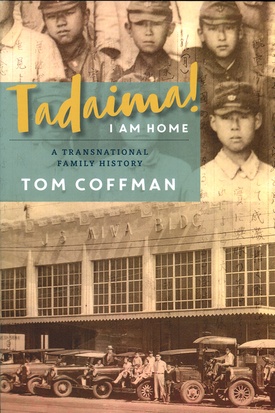The volume under review, the most recent of many documentary books by award-winning veteran independent researcher, writer, and producer Tom Coffman, characteristically incorporates historical themes pertaining to Hawai‘i. What makes Tadaima! I Am Home different, however, is that its focus is upon a Hawai‘i Nikkei family history as viewed from a multigenerational, transnational perspective.
Within its short compass, readers are provided with a fascinating five-generation exploration by Coffman of male Miwa family members extending from its fallen samurai progenitor in Meiji Era Japan, Marujiro Miwa (1850-1919), down through four sons of successive generations — all of whom are bound together by having their lives similarly enacted in both Japan (mostly Hiroshima) and America (Hawai‘i and the U.S. mainland).
The book’s origins story features the Miwa family’s most recent descendant, Stephen H. Miwa (1963- ) and his quest to excavate his family’s roots, with particular attention to why his late mother had ominously apprised him that, owing to the family being deemed “unlucky,” he might well not want to unearth its lineage.
Undaunted by this forewarning, Stephen then sought and gained useful oral and written information from his father, Lawrence Fumio Miwa (1931- ) to facilitate his quest, and thereafter commissioned Coffman to flesh out the Miwa family story. Aided by two researchers from Japan affiliated with the Hawai‘i State Archives who were not only interested in transnational migration, but also able to instruct him in how to access archives in Japan and utilize other invaluable resources, Coffman was empowered to produce a book that represents a quintessential model of the new and enriched family history.
Although the stories of the five Miwa generations are intermingled throughout Coffman’s book, the basic organization is the sequential exposition of each generational representative’s transnational experience contextualized by salient information relevant to his respective time period. While the experiences of all five generations are noteworthy, the one I found most captivating was that with Lawrence Fumio Miwa.
Born in Honolulu as a U.S. citizen, when he was 2 years old, in 1933, his father moved him to Japan to be rejoined with his mother and two older siblings. There he attended a series of schools. Then called by his Japanese name of Fumio, he was indoctrinated with military propaganda and became an unquestioning captive and chauvinistic proponent of it.
Just prior to his 14th birthday, on July 3, 1945, school officials told him and his classmates that they were being relocated to the countryside, to a village located about 25 miles east of downtown Hiroshima, “to serve the emperor by growing vegetables” (pp. 96). On that same date, he and his fellow students were instructed to begin maintaining a “self-reflection diary.” The very next month Fumio’s diary would record a catastrophic historical event. Because of a disciplinary action, Fumio and two other boys, who were scheduled on August 6 to visit their parents in Hiroshima, were substituted for by three different and tragically unlucky boys.
Although Fumio did not witness or experience the atomic bombing of his hometown, nine days later, on August 15, he and his classmates were permitted to travel to Hiroshima to take a still-operating train into the city to assay the extent of its destruction and the highly possible loss of life of their family members. While some quarter of a million homes had been devastated, at the flattened Miwa house, Fumio miraculously discovered a written message affixed to the concrete wall of the well that read, in his father’s hand, “Parents safe,” along with an address where he could locate his family.
My recommendation of this book is that consumers of this review should either buy it or borrow it and by all means read it and reflect upon its abundant contents. The sole reservation I have about this book is one I found in an anonymous assessment that appeared in Publishers Weekly, and which I here somewhat reluctantly second: “Unfortunately, he (Tom Coffman) focuses exclusively on the Miwa men, obscuring women’s contributions to their transnational life and limiting the book’s impact.”
TADAIMA! I AM HOME: A TRANSNATIONAL FAMILY HISTORY
By Tom Coffman
(Honolulu: University of Hawai‘i Press, 2018, 176 pp., $17.99, paperback)
* This article was originally published in Nichi Bei Weekly on July 18, 2019.
© 2019 Arthur A. Hansen and Nichi Bei Weekly








